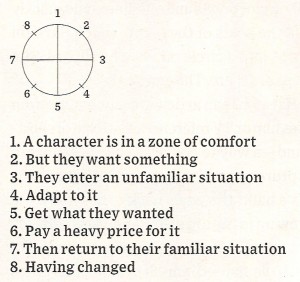Follow Scott
Recent Tweets
- Waiting for Twitter... Once Twitter is ready they will display my Tweets again.
Latest Photos
Search
Tags
anniversary Balticon birthdays Bryan Voltaggio Capclave comics Cons context-free comic book panel conventions DC Comics dreams Eating the Fantastic food garden horror Irene Vartanoff Len Wein Man v. Food Marie Severin Marvel Comics My Father my writing Nebula Awards Next restaurant obituaries old magazines Paris Review Readercon rejection slips San Diego Comic-Con Scarecrow science fiction Science Fiction Age Sharon Moody Stan Lee Stoker Awards StokerCon Superman ukulele Video Why Not Say What Happened Worldcon World Fantasy Convention World Horror Convention zombies
©2025 Scott Edelman
The symmetry of how stories are told
Dan Harmon, the creator of the TV series Community, has a theory about the shape of stories, one which was shared in a profile recently published in Wired. It’s different from any other story shape I’ve seen, in that it’s circular, rather than the usual X-Y graph reflecting highs and lows, whether of fortune, or tension, or some other plot element.
He says that when watching movies and TV, “I can’t not see that circle. It’s tattooed on my brain.”
Here’s how he lays it out.
It makes for an interesting theory, but it’s not one I’m comfortable with accepting as the skeleton of story, due partially to the circle and partially the fact that I don’t see many of these numerical concepts as being universal.
For example—
#3) Must the character always enter into an unfamiliar situation? What if he or she simply refuses to put up any longer with an ongoing situation and says “Enough!” But let’s say we allow that refusal to go on with the status quo to be an unfamiliar situation, at least metaphorically. That leads us to …
#4) I don’t see adapting to that situation to be present in all stories. What about the stories that exist because the protagonist fails to adapt? And …
#5 & 6) Must the protagonist always get what he or she wanted and then pay a heavy price for it? Many times the character never gets what he or she wants, and pays a price for THAT. Or gets what he or she wants and pays no price at all. Also …
#7) Must they really return to their familiar situations? I don’t think so. Often, stories result in the characters’ familiar worlds being shattered, and thus being unable to go back.
I do strongly agree with #8, however, because the lack of the character “having changed” is a frequent failure of fiction. I’ve always agreed with the Bruce Sterling definition of a short story as being the most important moment in a person’s life. After that moment, the person is no longer the same. But while we agree there, I don’t really see the whole of Harmon’s arc, if I can properly call it an arc, since it’s a circle that implies an ending where it all began.
I much prefer the shapes as offered up by Kurt Vonnegut, who can be seen in the video below charting out some familiar stories.
Am I missing something? Are you someone who, like Harmon, “can’t not see that circle”? If so, chime in so that the scales may fall from my eyes!
2 Comments for The symmetry of how stories are told
kzrb
I think his real intention is to say that this is a common formula for sitcoms, not all tv/film media, and that he tries to follow it while writing community. Personally, I dislike the circular nature of sitcoms. I much prefer linear stories, which is where premium TV seems to be going (e.g. Breaking Bad). I wonder if this circular idea is just a holdover from the days of studio audiences and low production value shows. How can the story constantly change if the set is always the same?


Brian
Yeah, I think I agree with you. It may be a nice geometric shape, but it hardly holds true for all stories. For some reason I was thinking movies when I looked at this, not necessarily printed fiction. But stories is stories and … the Cohen Brothers seem to revel in making films where a lot goes on but the main character returns to where he was with little or no change. (ie, Big Lebowski, O Brother Where Art Thou, and, if I’m remembering correctly Miller’s Crossing.) I suppose you could argue any amount of change is change. But yeah, this circle theory seems to be trying to fit everything into a nice little shape but I don’t think it’s accurate.
The dude abides.
Thanks for sharing!